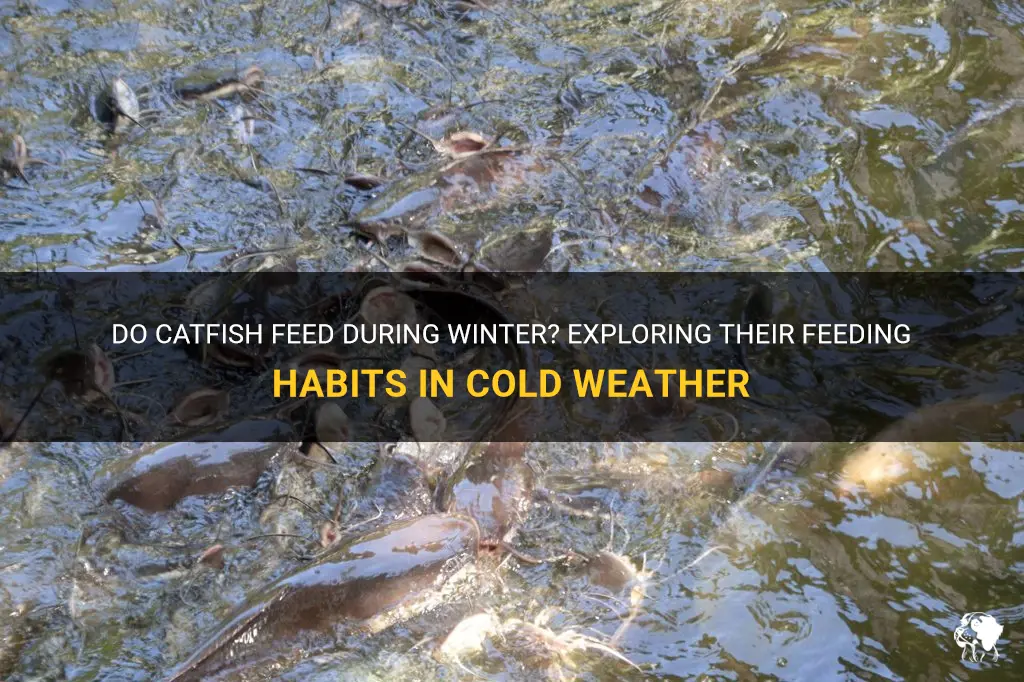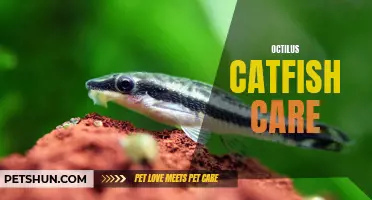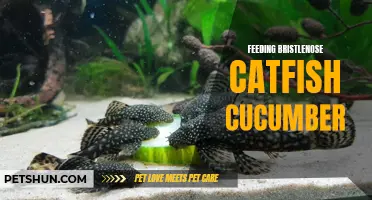
Catfish are known for being voracious eaters, but have you ever wondered if they continue to feed in cold weather? As the temperature drops, many fish species slow down and go into a hibernation-like state, but catfish are a different story. These bottom-dwelling creatures are surprisingly active and continue to hunt for food even in chilly waters. So, how do catfish survive and feed in cold weather conditions? Let's dive in and explore the fascinating world of catfish feeding habits during winter!
| Characteristics | Values |
|---|---|
| Temperature Range | 10-20 degrees Celsius |
| Metabolism | Slows down |
| Activity Level | Decreases |
| Feeding Behavior | Decreases |
| Digestion | Slows down |
| Growth Rate | Slows down |
| Appetite | Decreases |
| Immune System | Weakened |
| Oxygen Consumption | Decreases |
| Fish Diseases | More prone to infections |
| Survival Rate | Decreases |
What You'll Learn
- Do catfish feed less frequently in cold weather than in warm weather?
- What factors affect catfish feeding behavior in cold weather?
- Are catfish more active during certain times of day in cold weather?
- Do catfish prefer different types of bait in cold weather compared to warm weather?
- Are there specific fishing techniques that are more effective for catching catfish in cold weather?

Do catfish feed less frequently in cold weather than in warm weather?
For many anglers and fish enthusiasts, one common question is whether catfish feed less frequently in cold weather compared to warm weather. This is an interesting topic to explore, as it can help us better understand the feeding behavior of catfish and improve our chances of catching them in different weather conditions.
To answer this question, we can look at both scientific studies and personal experiences of anglers who have spent countless hours on the water fishing for catfish. Let's dive in and explore the factors that may influence the feeding habits of catfish in different temperatures.
- Biological Factors: Catfish are ectothermic organisms, which means their body temperature is regulated by the environment. During colder months, their metabolism slows down, and they become less active. This decrease in metabolic rate can result in reduced feeding frequency. Additionally, the availability of food sources may decrease in colder weather, leading to less frequent feeding.
- Water Temperature: Water temperature plays a crucial role in the feeding habits of catfish. As the water temperature drops, catfish become less active and their metabolism slows down. This decrease in activity often translates to lesser feeding frequency. However, it's important to note that catfish are still opportunistic feeders, and they will actively search for food even in colder water temperatures. They may concentrate their feeding activities during warmer periods of the day when the water temperature is slightly higher.
- Seasonal Changes: Catfish exhibit different seasonal feeding patterns throughout the year. In colder months, they tend to consume less food compared to warmer months. This is often due to the scarcity of food sources and their decreased metabolism. In contrast, during warmer months, catfish become more active and feed more frequently as their metabolism increases, and food sources become more abundant.
- Experience of Anglers: Experienced anglers often observe certain patterns and behaviors in catfish. Many report that catfish feeding tends to slow down in colder weather conditions. They may need to adjust their fishing techniques and presentation to entice catfish to bite. This could involve using smaller baits, fishing at different depths, or employing different types of scent attractants to lure catfish into feeding.
- Example: Let's consider a scenario where an angler is fishing for catfish in the fall. As the water temperature starts to drop, the angler may notice a decrease in the frequency of bites. However, if the angler adjusts their fishing strategy, they may still be able to catch catfish by targeting feeding windows when the water temperature rises slightly, such as during midday hours. This example highlights the importance of understanding the relationship between water temperature and catfish feeding behavior.
In conclusion, catfish tend to feed less frequently in cold weather compared to warm weather. The decrease in metabolic rate, availability of food sources, and overall activity levels contribute to this change in feeding behavior. However, it's important to note that catfish are still opportunistic feeders, and with the right techniques and adaptations, anglers can still have success in catching them even in colder weather conditions. Understanding the factors that influence catfish feeding habits can help anglers be more prepared and increase their chances of a successful fishing trip.
The Top Catfish Feed for Optimal Growth and Health in Nigeria
You may want to see also

What factors affect catfish feeding behavior in cold weather?
Title: Understanding Catfish Feeding Behavior in Cold Weather: Factors and Considerations
Introduction:
Catfish are known for their opportunistic feeding behavior, but their feeding patterns can significantly change in cold weather. Several factors influence catfish feeding behavior, and understanding these factors is essential for successful catfish angling during colder months. In this article, we will explore the various elements that affect catfish feeding behavior in cold weather and provide insights into how anglers can adapt their strategies accordingly.
Temperature:
The primary factor influencing catfish feeding behavior in cold weather is water temperature. As water temperatures drop, the metabolism of catfish slows down, and their feeding activity decreases. In general, catfish become more lethargic in colder water and therefore require less food to sustain themselves. Conversely, when water temperatures rise, catfish will become more active and feed more frequently.
Oxygen Levels:
Another vital consideration for catfish feeding behavior in cold weather is the oxygen levels in the water. Cold water can hold more dissolved oxygen, providing optimal conditions for catfish survival. High oxygen levels can enhance the metabolism of catfish, thereby increasing their feeding activity. On the other hand, when oxygen levels decrease, catfish may become less active and reduce their feeding frequency.
Light Levels:
The amount of light available can also influence catfish feeding behavior in cold weather. In general, catfish are more active during low-light conditions, such as dawn, dusk, and nighttime. As daylight decreases during colder months, catfish may exhibit more nocturnal feeding behaviors. This is important to consider for anglers who prefer night fishing for catfish during the winter season.
Food Availability:
Food availability is a crucial factor that affects catfish feeding behavior throughout the year. In cold weather, the primary food sources for catfish, such as baitfish and other aquatic organisms, may become less abundant or less active. It is important to recognize these changes in food availability and adjust fishing strategies accordingly. Utilizing scent-based baits or choosing alternative baits that mimic the natural prey can increase the chances of enticing catfish to bite.
Water Depth:
The depth at which catfish are found can greatly impact their feeding behavior in cold weather. As water temperatures plummet, catfish tend to move to deeper areas where the water remains relatively warmer. Deeper water tends to provide a more stable thermal environment for catfish, influencing their overall activity and feeding patterns. Hence, targeting deeper areas can be more productive when fishing for catfish in colder weather.
Understanding the factors that affect catfish feeding behavior in cold weather is crucial for successful angling in winter months. By considering factors such as temperature, oxygen levels, light levels, food availability, and water depth, anglers can significantly improve their chances of catching catfish during colder weather conditions. Adapting fishing strategies and selecting appropriate baits based on these factors can enhance the overall fishing experience and increase the likelihood of a successful catch. So, next time you head out for winter catfishing, keep these factors in mind and increase your chances of a rewarding fishing outing.
Understanding Wallago Catfish Care: Tips for Keeping and Caring for Wallago Catfish
You may want to see also

Are catfish more active during certain times of day in cold weather?
Catfish are known for their ability to thrive in a variety of environments, including cold weather conditions. However, their activity levels may vary depending on the time of day. In this article, we will explore whether catfish are more active during certain times of day in cold weather and how this may affect your fishing strategies.
Unlike many other fish species, catfish are known to be more active during the night. This behavior is not limited to warm weather conditions but can also be observed during cold weather. Catfish have a unique adaptation called a "lateral line" that allows them to sense vibrations in the water. This adaptation helps them locate prey even in low-light conditions, making them more active during the night.
During cold weather, catfish may exhibit even more nocturnal behavior. As water temperatures drop, catfish may become less active during the day and seek shelter in deeper, warmer waters. They may also become less active in cold weather due to metabolic changes that slow down their digestion and overall activity levels.
To increase your chances of catching catfish during cold weather, it is recommended to fish during their most active periods, which are typically at dawn and dusk. During these times, catfish may be more willing to venture out of their hiding spots in search of prey. Additionally, as the sun starts to rise or set, the light levels in the water may be low enough for catfish to feel comfortable and confident in their hunting abilities.
When fishing for catfish in cold weather, it is important to take into consideration the water temperature and the location of the fish. Catfish tend to congregate in areas with deeper water, such as river bends, deep holes, or submerged structures. These areas provide them with the warmth and protection they need during the colder months.
One effective fishing technique during cold weather is to use bait that emits strong scents. Catfish have highly developed olfactory senses and can detect food from a distance. Using bait such as chicken liver, cut fish, or stink bait can help attract catfish to your fishing spot.
In addition to bait choice, it is crucial to use appropriate fishing gear when targeting catfish in cold weather. Since catfish tend to grow larger in colder waters, it is essential to use heavy-duty fishing rods and lines capable of handling the weight and strength of a potentially big catfish. Furthermore, using a sensitive fishing rod tip can help you detect subtle strikes from inactive catfish.
In conclusion, while catfish are known to be more active during the night regardless of the weather conditions, they may exhibit even more nocturnal behavior during cold weather. Fishing during their most active periods at dawn and dusk can increase your chances of success. Additionally, using bait that emits strong scents and targeting areas with deeper water can attract catfish to your fishing spot. By using appropriate fishing gear and tactics, you can have a rewarding catfishing experience even in cold weather.
Essential Tips for Long Nose Whiptail Catfish Care: A Complete Guide
You may want to see also

Do catfish prefer different types of bait in cold weather compared to warm weather?
When it comes to catfishing, choosing the right bait can make all the difference. But does the type of bait that catfish prefer change with the seasons? In particular, do catfish have different preferences in cold weather compared to warm weather? Let's explore the science, experiences, step-by-step approach, and examples to find out.
Scientific studies have shown that catfish are opportunistic feeders and will devour a wide range of baits. However, their preferences can be influenced by environmental factors, including water temperature. In cold weather, catfish tend to be more sluggish and less active, which means they may have different feeding habits and bait preferences compared to warmer months.
One common theory is that catfish are more likely to go for smellier, oilier baits in cold weather. This could be due to the fact that their metabolism slows down in the colder temperatures, making them rely more on scent detection for finding food. Some anglers swear by using oily baits like chicken liver or shrimp in the winter months, as the strong odors can help attract catfish even in low visibility conditions.
Another bait that has been proven to attract catfish in cold weather is cut bait. This refers to using pieces of fish, such as shad or skipjack, as bait. The natural oils and strong smell of the cut bait can be irresistible to catfish, especially when the water is cold and their metabolism is slower.
In contrast, during warmer months, catfish may be more active and have a wider variety of food sources available to them. This can make them less likely to focus on a specific type of bait. However, some anglers still find success using smelly baits like chicken liver or stinkbaits, as catfish are known to have a strong sense of smell year-round.
When it comes to finding the right bait for catfish, a step-by-step approach can be helpful. Start by researching the catfish population in the area you plan to fish. Find out what type of bait has been successful in the past and talk to local anglers for their recommendations. Experiment with different baits and techniques to see what works best.
For example, one angler may find that using live worms or minnows produces the best results in cold weather, while another angler may have success with prepared baits like dough balls or chicken liver. Ultimately, it's important to understand that catfish behavior and bait preferences can vary from one body of water to another.
In conclusion, catfish may have different bait preferences in cold weather compared to warm weather. While scientific studies have shown that catfish are opportunistic feeders and will eat a variety of baits, their preferences can be influenced by environmental factors like water temperature. Using smelly, oily baits like chicken liver or cut bait has been proven to be effective in attracting catfish during colder months. However, it's important to experiment and learn what works best in your specific fishing area. So, before you head out for a catfishing trip, make sure to do your research, talk to local anglers, and be prepared to adapt your bait choices based on the season and water conditions.
Baby Catfish Care Sheet: Essential Tips for Raising Happy and Healthy Catfish
You may want to see also

Are there specific fishing techniques that are more effective for catching catfish in cold weather?
When it comes to fishing for catfish in cold weather, there are a few specific techniques that can greatly increase your chances of success. Whether you're a seasoned angler or just starting out, these techniques can help you reel in more catfish during the colder months.
- Choose the right location: Catfish are cold-blooded creatures, meaning their metabolism slows down in cold water. This makes them less active and more likely to take cover in deeper areas or near structures. Look for areas with depth and structure, such as deep holes, submerged trees, or brush piles. These areas provide catfish with a place to shelter from the cold and ambush their prey.
- Slow down your presentation: In cold weather, catfish are less likely to chase after fast-moving baits. Instead, opt for slower presentations that allow the catfish enough time to react and strike. This can include using a stationary bait, such as a live or dead minnow or cut bait, or slow-rolling a soft plastic lure along the bottom. By slowing down your presentation, you increase the chances of enticing a cold and sluggish catfish to bite.
- Use scent: Catfish have a highly developed sense of smell, and using scented baits can be highly effective in cold weather. The combination of scent and slower presentations can make it easier for catfish to locate your bait and strike. Consider using scent attractants, such as blood bait, garlic scents, or commercial catfish attractants, to enhance your bait's effectiveness.
- Fish during the warmest part of the day: In cold weather, catfish tend to be more active during the warmest part of the day when the water temperature is slightly higher. This is often midday when the sun is at its peak and has had a chance to heat up the water. Plan your fishing trip accordingly and focus your efforts during these warmer periods for increased success.
- Adjust your tackle: The slower and more methodical approach to catfishing in cold weather often requires adjustments to your tackle setup. Use heavier sinkers to keep your bait anchored closer to the bottom, as catfish are less likely to venture far from their cover in cold water. Additionally, consider using a rod with a sensitive tip to detect subtle bites in the colder water. Finally, use a heavier line to handle potentially larger catfish that tend to group together in colder weather.
By following these techniques, you'll increase your chances of catching catfish in cold weather. Remember to always check local fishing regulations and obtain the necessary licenses before heading out. Happy fishing!
The Complete Guide to Debauwi Catfish Care: Essential Tips and Advice for a Happy and Healthy Fish
You may want to see also
Frequently asked questions
Yes, catfish can still feed in cold weather, although their feeding activity may decrease. In colder temperatures, catfish tend to become less active and their metabolism slows down, which affects their feeding behavior. However, they can still be caught if baited properly and presented at the right depth.
In cold weather, it is essential to use baits that have a strong odor and are appealing to catfish. Some popular bait options include nightcrawlers, chicken liver, shrimp, and stink baits. It is important to use fresh bait and present it close to the bottom of the water, where catfish are more likely to be feeding during cold weather.
During cold weather, catfish tend to move to deeper areas of the water where the temperature is more stable. Look for areas with structure such as drop-offs, submerged logs, or deep holes. These spots provide cover for catfish and are more likely to hold fish during cold weather. It is recommended to use a fish finder or depth finder to locate these areas and increase your chances of finding active feeding catfish.







